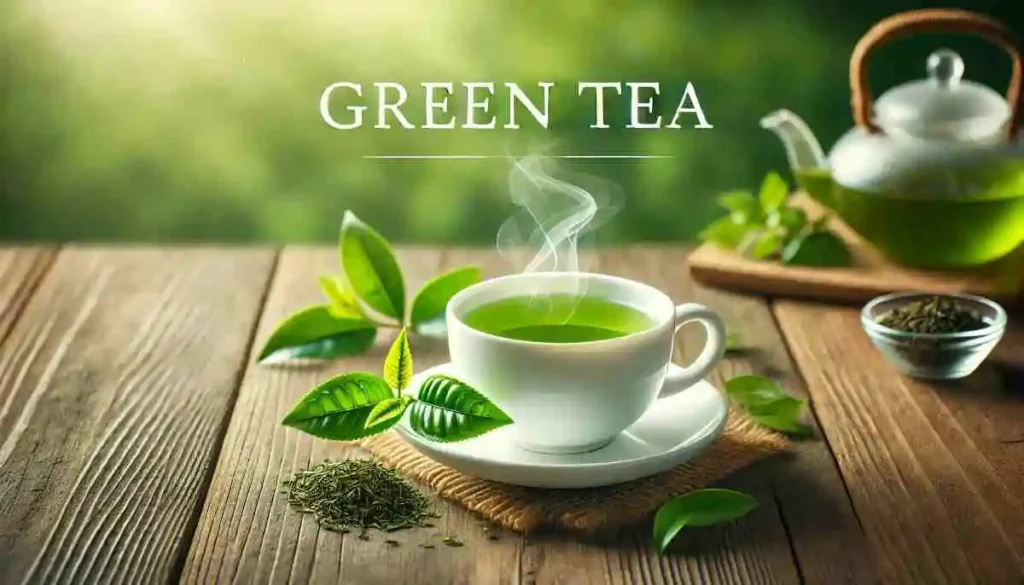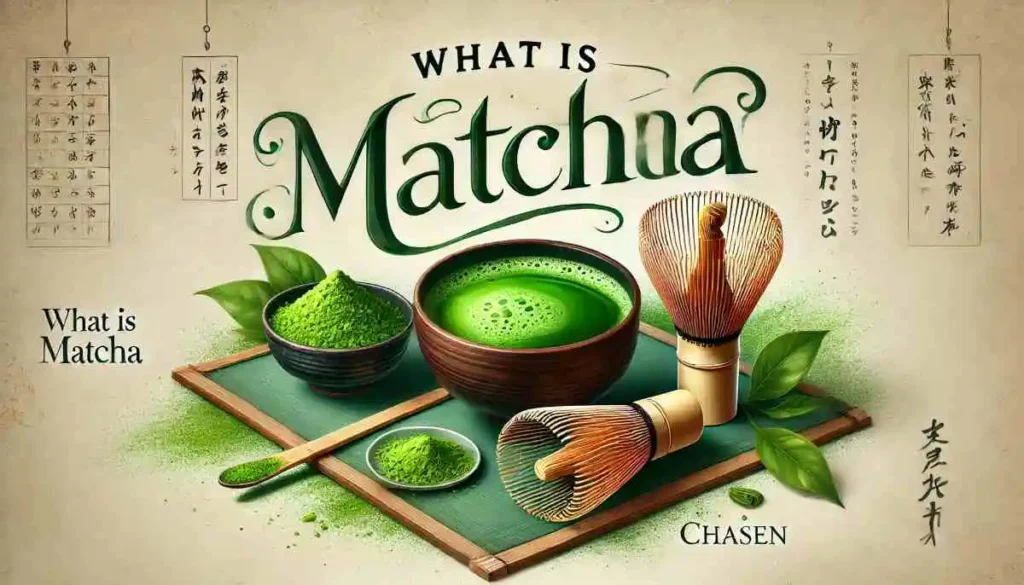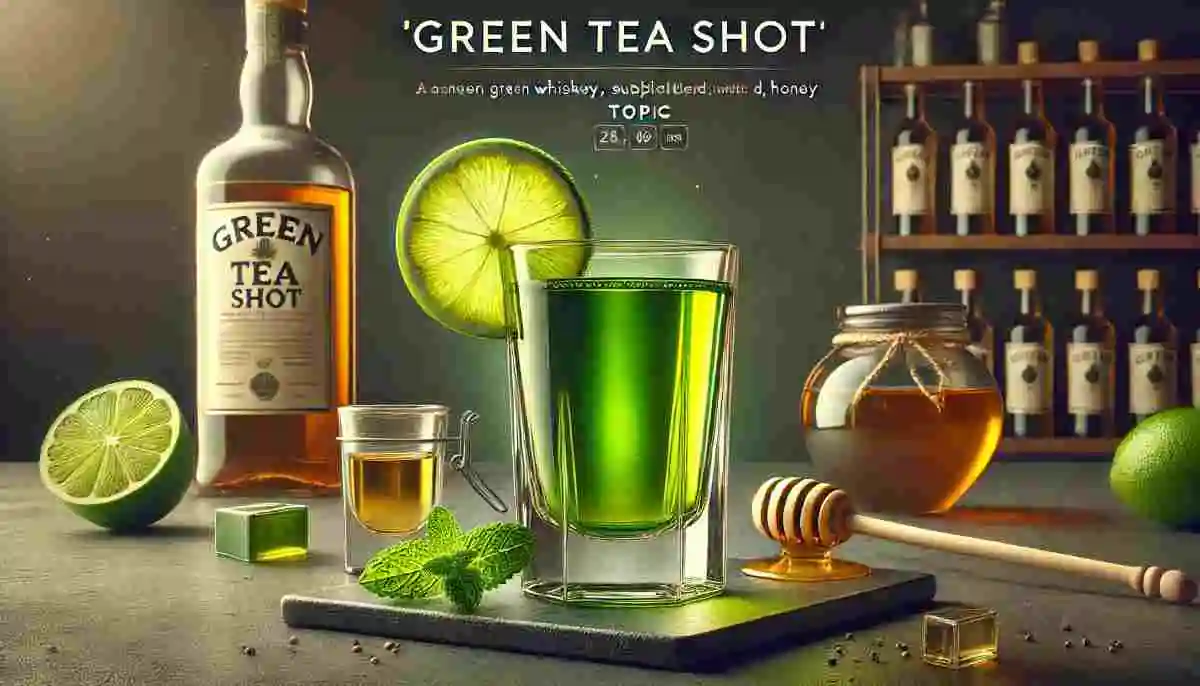What is a Green Tea Shot?
A Green Tea Shot is a popular alcoholic beverage known for its vibrant green color, reminiscent of green tea, although it doesn’t contain any tea. The shot is normally made with a mix of Jameson Irish Bourbon, peach schnapps, sharp blend, and a sprinkle of lemon-lime pop, making a sweet and tart flavor profile that is both invigorating and simple to drink.
The origins of the Green Tea Shot are somewhat obscure, but it is widely believed to have been created by bartenders looking to offer a fun, new shooter that would appeal to a wide audience. Its unique color and delicious taste quickly made it a hit in bars and clubs across the United States and beyond. The shot is particularly popular among those who prefer a milder, sweeter drink compared to more traditional, stronger shots.
Key Takeaways
- The Green Tea Shot is a trendy, vibrant shooter that has gained immense popularity for its delightful taste and easy-to-make recipe.
- Although named after green tea, the shot does not contain any tea but is instead made with ingredients like Jameson Irish Whiskey, peach schnapps, and sour mix.
- There are many variations of the green tea Shot Shot, allowing for creativity in ingredients and flavors, making it adaptable to different tastes and dietary needs.
- It’s important to consider the health implications of consuming alcohol, including moderation and understanding the calorie content of the drink.
- Whether you’re making it at home or ordering it at a bar, the Green Tea Shot is a versatile and enjoyable option that’s perfect for a variety of occasions.
Green Tea Benefits
Green Tea Shot is one of the most widely consumed beverages in the world, revered not only for its refreshing taste but also for its numerous health benefits. Originating in China and Japan, green tea has been a staple in traditional medicine for centuries. Here are some of the key benefits associated with drinking green tea:
Rich in Antioxidants
Green tea is loaded with powerful antioxidants called catechins, the most notable of which is epigallocatechin gallate (EGCG). These antioxidants help protect the body from oxidative stress caused by free radicals, which can contribute to various chronic diseases such as heart disease, cancer, and aging.
Boosts Metabolism and Aids in Weight Loss
Green tea is frequently connected with weight reduction because of its capacity to help digestion. The catechins and caffeine in green tea Shots work together to enhance fat burning, especially during exercise. Regular consumption of Green Tea Shot can help increase energy expenditure and promote fat oxidation, making it a popular choice for those looking to shed extra pounds.
Supports Heart Health
Green Tea Shot has been shown to improve several heart health markers, including lowering LDL (bad) cholesterol levels and reducing blood pressure. The antioxidants in green tea can help prevent the oxidation of LDL cholesterol, which is a key factor in the development of heart disease. Additionally, the polyphenols in green tea may help improve blood flow and reduce the risk of stroke.
Improves Brain Function
The caffeine in green tea, though less than in coffee, is enough to produce a mild stimulant effect, which can improve brain function, mood, and reaction time. Moreover, green tea contains L-theanine, an amino acid that works synergistically with caffeine to enhance brain function, promoting relaxation without drowsiness.
Reduces the Risk of Cancer
Green tea’s high antioxidant content, particularly EGCG, is believed to have protective effects against certain types of cancer. Studies have shown that regular green tea Shot consumption may lower the risk of breast cancer, prostate cancer, and colorectal cancer. The antioxidants help neutralize harmful free radicals that can damage cells and lead to cancerous growths.
Promotes Healthy Skin
The antioxidants and anti-inflammatory properties of green tea are beneficial for skin health. Green tea can help protect the skin from UV damage, reduce redness, and prevent premature aging. Topical applications of green tea extract are often used in skincare products to improve skin elasticity and reduce the appearance of wrinkles.
Supports Immune Function
Green tea has been shown to boost the immune system, thanks to its antibacterial and antiviral properties. The catechins in Green Tea Shot can inhibit the growth of bacteria and viruses, which can help reduce the risk of infections. Regular consumption of green tea may also enhance immune response and reduce the frequency of colds and flu.
Improves Oral Health
The catechins in green tea also have antimicrobial properties that can benefit oral health. Green tea consumption has been linked to a reduction in the growth of harmful bacteria in the mouth, which can lower the risk of cavities, gum disease, and bad breath. Some studies suggest that green tea may even help prevent oral cancer.
Helps Regulate Blood Sugar Levels
Green tea may aid in managing blood sugar levels and reducing the risk of type 2 diabetes. The polyphenols in green tea Shots help regulate glucose levels in the body by improving insulin sensitivity and reducing blood sugar spikes after meals. This can be particularly beneficial for individuals with or at risk of developing diabetes.
Promotes Longevity
With its wide range of health benefits, it’s no surprise that green tea is associated with a longer lifespan. In regions where green tea consumption is high, such as Japan, people tend to live longer and have lower rates of chronic diseases. Regular green tea drinkers may enjoy a longer, healthier life due to the protective effects of its antioxidants and other beneficial compounds.
Green Tea Shot Recipe
Ingredients
- 1/2 ounce Irish whiskey: Jameson Irish Whiskey is the preferred choice for this recipe, offering a smooth, slightly sweet flavor that blends perfectly with the other ingredients.
- 1/2 ounce peach schnapps: This adds a fruity sweetness to the shot, balancing the strong flavor of the whiskey with a refreshing peachy note.
- 1/2 ounce sweet-and-sour mix: The sweet-and-sour mix gives the shot its signature tangy taste. You can use a store-bought mix or make your own at home for a fresher flavor (recipe below).
- Lemon-lime soda (such as 7Up or Sprite), to top: A small splash of soda adds a fizzy finish to the shot, enhancing its refreshing quality.
Steps
- Add the whiskey, schnapps, and sweet-and-sour mix into a shaker with ice: Start by pouring the Irish whiskey, peach schnapps, and sweet-and-sour mix into a cocktail shaker filled with ice. The ice helps to chill the ingredients, ensuring the shot is served cold and refreshing.
- Shake to chill: Secure the lid on the shaker and give it a good shake, about 10-15 seconds. This chills the ingredients and ensures they are well-mixed, resulting in a consistent flavor throughout the shot.
- Strain into a shot glass: Once the mixture is well-chilled, strain it into a shot glass. The bright green color of the shot will be immediately noticeable, making it a visually appealing drink.
- Top with a small splash of lemon-lime soda: Finish the shot by adding a small splash on top. This adds a slight fizziness and a hint of citrus that complements the other flavors, making the shot even more enjoyable.
Sweet-and-Sour Mix Recipe
To make your sweet-and-sour mix, combine the following ingredients:
- 1 part lemon juice
- 1 part lime juice
- 2 parts simple syrup (Simple syrup is made by dissolving equal parts sugar and water over low heat until the sugar is fully dissolved. Let it cool before using.)
Types of Tea
Green Tea

Green tea is known for its delicate flavor and health benefits. It undergoes minimal oxidation during processing, which helps retain its green color and fresh taste. Popular in many cultures, especially in Japan and China, green tea is often steamed or pan-fired to prevent oxidation.
Oolong Tea

Oolong tea is partially oxidized, placing it between green and black tea in terms of flavor and color. It is primarily produced in China and Taiwan and can range from light and floral to rich and robust, depending on the degree of oxidation and the specific processing methods.
Black Tea

Black tea is fully oxidized, resulting in a dark color and strong flavor. It’s one of the most commonly consumed types of tea worldwide. Well-known assortments incorporate English Breakfast, Baron Dim, and Darjeeling. Dark tea is frequently filled with milk and sugar.
White Tea

White tea is the least processed of all teas, made from young leaves and buds that are simply withered and dried. This minimal processing results in a light, delicate flavor that is often slightly sweet and floral. White tea is known for its subtle taste and potential health benefits.
Pu-erh Tea

Pu-erh tea is a fermented and aged tea from China, known for its deep, earthy flavor. It is often compressed into cakes and can be aged for many years, increasing its value and enhancing its complex taste. Pu-erh tea is unique due to its fermentation process, which continues over time.
Herbal Tea

Herbal tea is not technically tea, as it doesn’t come from the Camellia sinensis plant. Instead, it is made from a variety of herbs, flowers, spices, and fruits. Popular herbal teas include chamomile, peppermint, and hibiscus. Herbal teas are often caffeine-free and enjoyed for their diverse flavors and potential health benefits.
Yellow Tea

Yellow tea is a rare and unique type of tea that undergoes a similar process to green tea but is dried more slowly, allowing the leaves to develop a yellow hue. It has a mild flavor, often described as being somewhere between green and white tea, with a slightly sweet and mellow taste.
Boba Tea Near Me: The Ultimate Guide to Finding the Best Bubble Tea
Introduction to Boba Tea
Boba tea, otherwise called bubble tea, is a famous beverage that began in Taiwan. It consists of a tea base mixed with milk or fruit, and chewy tapioca pearls (boba) that add a unique texture. With the growing popularity of this delightful beverage, finding a good boba tea spot near you has never been easier.
What Makes a Great Boba Tea Spot?
When searching for the best boba tea near you, several factors come into play. The quality of the tea, the texture of the boba, and the variety of flavors are all important. Additionally, a great boba tea spot should offer customizable options, such as sugar levels and the choice of toppings, to cater to your personal preferences.
Popular Boba Tea Flavors to Try
There’s a wide range of flavors available when it comes to boba tea. From classic options like milk tea and taro to more adventurous choices like matcha or fruit-infused teas, there’s something for everyone. Exploring different flavors can help you discover your new favorite drink.
How to Find the Best Boba Tea Near You
With numerous boba tea shops popping up, finding the best one nearby can be a challenge. Use apps like Yelp or Google Maps to read reviews and see ratings from other boba enthusiasts. Don’t be afraid to explore new places and ask for recommendations from friends or family.
Top Boba Tea Chains and Local Favorites
In addition to popular boba tea chains like Kung Fu Tea, Gong Cha, and CoCo Fresh Tea & Juice, many cities have local favorites that offer unique flavors and ambiance. Visiting both well-known chains and local shops can give you a broader experience of what the boba tea scene has to offer.
Customizing Your Boba Tea Experience
One of the best things about boba tea is the ability to customize your drink. You can choose the sweetness level, add or remove toppings like jelly or pudding, and even select different types of boba, such as popping boba or mini pearls. This customization ensures that your drink is tailored to your taste.
Health Considerations When Drinking Boba Tea
While boba tea is a delicious treat, it’s important to be mindful of its nutritional content. Some boba drinks can be high in sugar and calories. Opting for lower sugar levels, choosing fruit-based teas, or even asking for almond or soy milk can make your boba tea a healthier option.
Best Times to Enjoy Boba Tea
Boba tea can be enjoyed at any time of the day, but some people find it particularly refreshing in the afternoon as a pick-me-up or after a meal as a dessert. Knowing the best times to enjoy boba tea can enhance your experience.
Creating Boba Tea at Home
For those who want to enjoy boba tea from the comfort of their home, there are plenty of DIY kits available. Making boba tea at home allows you to experiment with different flavors, teas, and boba types. It’s a fun and rewarding experience that can lead to discovering your perfect boba recipe.
What is Matcha?

Matcha is a finely ground powder produced using uncommonly developed and handled green tea leaves. Unlike traditional green tea, where leaves are steeped in water and then discarded, matcha involves consuming the entire leaf, which provides a higher concentration of nutrients and beneficial compounds.
Production Process of Matcha
Matcha is produced from the Camellia sinensis plant, the same plant used to make all types of green tea. However, the production process for matcha is unique and involves growing the plants in the shade. This concealing system expands the chlorophyll content in the leaves, giving matcha its dynamic green tone. Additionally, shading boosts the levels of certain beneficial compounds, particularly an amino acid called L-theanine, which is known to promote relaxation and enhance concentration.
The shade-grown leaves, known as tench, are carefully harvested, and their stems and veins are removed. The remaining leaves are then stone-ground into a fine powder, which is what we know as matcha.
Health Benefits of Matcha
One of the most significant benefits of matcha is its potential to boost concentration and cognitive function, largely due to the presence of L-theanine. This amino acid, combined with the caffeine naturally found in tea leaves, creates a state of calm alertness, making matcha a popular choice for those seeking enhanced mental clarity and focus.
How to Prepare Matcha
Matcha is traditionally prepared by whisking the powder into hot water using a bamboo tea whisk, known as a chase. This method creates a frothy, smooth tea with a bright green color. The flavor of matcha is mellow and slightly sweet, without the bitterness sometimes associated with other types of green tea.
Different Grades of Matcha
Matcha is available in different grades, each suited to different uses:
- Ceremonial Grade: The highest quality of matcha, used in traditional Japanese tea ceremonies. It has a delicate flavor and is usually consumed on its own.
- Premium Grade: Suitable for daily consumption, this grade offers a balance between quality and cost, making it ideal for those who drink matcha regularly.
- Cooking Grade: The most affordable grade, often used as a flavoring in desserts and culinary dishes rather than for drinking.
Global Popularity of Matcha
Originally used in Japanese tea ceremonies, matcha has gained worldwide popularity as a healthful beverage. Its rich concentration of antioxidants, vitamins, and minerals makes it a favorite among health enthusiasts. Matcha’s versatility also allows it to be used in various culinary applications, from lattes to desserts, further contributing to its global appeal.
FAQs
Q1. What is green tea?
A: Green Tea is a kind of tea produced using Camellia sinensis. The beverage blended from dry leaves is a famous drink in Asian Nations and is quite possibly one of the most well-known refreshments in Japan and China. It is acquiring ubiquity overall due to its various medical advantages.
Q2. What Does a Green Tea Shot Taste Like?
A: A Green Tea Shot offers a unique blend of sweetness from the peach schnapps, a slight tang from the sour mix, and a smooth finish from the whiskey. The combination creates a balanced, refreshing flavor that’s easy to enjoy.
Q3. Can You Make a Green Tea Shot Without Alcohol?
A: Yes, you can make a non-alcoholic version of a green tea Shot Shot by using green tea or lemonade as the base and adding flavors like peach syrup and a splash of lemon juice for the tang.
Q4. How Many Calories Are in a Green Tea Shot?
A: The calorie content in a Green Tea Shot can vary depending on the specific ingredients used, but on average, it contains about 150-200 calories per shot.
Q5. Does green tea help in weight loss?
A: Green tea is one richest natural sources of antioxidants called polyphenols (specifically epigallocatechin gallate (EGCG), catechins, theaflavins, tannins, and flavonoids). These cell reinforcements are known to have mitigating, pain relieving, and hostile to disease medical advantages. Green Tea is also known to aid weight loss, and control glucose, and is also a photo-protective agent that protects the skin, prevents tooth decay, and promotes bone density.
Conclusion
While green tea Shot offers numerous health benefits, it’s crucial to consume it mindfully and in moderation. Understanding the potential risks, such as caffeine sensitivity, interactions with medications, and the impact on iron absorption, can help you enjoy green tea Shot safely. As with any dietary choice, it’s always best to consider your individual health needs and consult with a healthcare provider if you have any concerns. By doing so, you can continue to enjoy the many advantages of green tea while minimizing any potential drawbacks.
